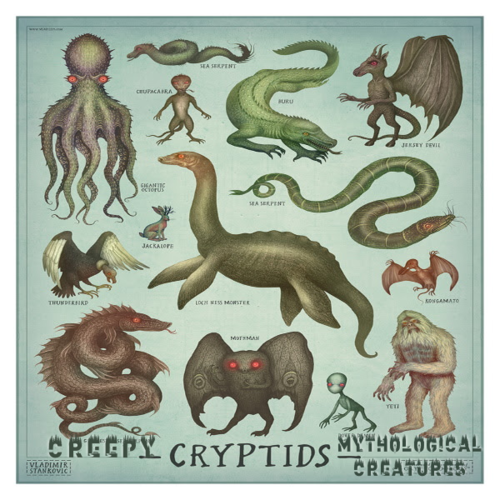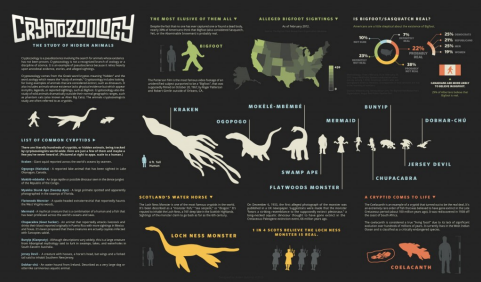Science behind cryptids
Omar Dajani. 12/18/2020

If you are an American, you likely have heard the name “Bigfoot” here and there in addition to the names “Yeti” and “Loch-ness Monster.” All three of these names correspond to “cryptids,” which are monsters that apparently roam our world. According to National Geographic, science has had a long battle with the existence of these monsters, due to the circumstantial evidence documenting their existence. Such evidence, which includes blurry pictures, strange footprints and eyewitness reports, is not enough for scientists to confirm their existence. While both factions are at war with each other, it is safe to say that science is the clear winner. Even so, the lore behind these cryptids and how they tie into the human psyche is interesting.
Some examples of cryptids were listed above, but it is important to know exactly what they are. Donald R. Prothero, a paleontologist who has written over 250 scientific reports, including a book discussing cryptids, defined them as “any animal that has never been described by science, usually something very unusual along the lines of a Loch Ness monster or Bigfoot, something that stretches the limits of what is scientifically plausible.” Prothero’s definition helps us understand that these cryptids cannot exist, as they seem to stretch what is scientifically possible within our world. Daniel Loxton, Prothero’s partner who helped him write the aforementioned book, added on to his definition, stating “It’s based on the word cryptozoology, which means hidden life or animals. It implies a creature that’s been recorded through folklore, something that we have reason to suspect exists.”
All that being said, how can science help us understand the world of cryptozoology more? First, for cryptids to exist, there cannot only be one cryptid of that species. Basically, Bigfoot is an offspring of other Bigfoot. The “monster” did not come into existence out of nowhere. The same goes for the other variety of cryptids. Speaking of which, the second way science can help us understand cryptids more is by their size. Many cryptids, such as giant squids and giant okapi, are abnormally large in size, so how is it possible that they have not been recently sighted at all? How would it be possible for them to avoid the public eye for as long as they have? Technology has been rapidly improving each year, making it so that finding these types of creatures should be no problem as of this point in time. The third and final way science can help us understand cryptids is not actually directly related to science itself, but rather the folklore and myths of old. In these stories, a lot of animals, such as bears, would exhibit human-like characteristics. People who know of these folklore stories and myths, upon seeing a weird looking bear, might not realize it is just a bear and think it is something more mystical as a result of these old stories. This is a solid example of the complexities of the human psyche and is also why it is important to take people’s eye-witness reports with a grain of salt. Our senses (especially that of sight) can sometimes fool us into thinking we saw something mysterious when it was but a mere shadow of some normal animal.

With all the above, it is quite obvious that cryptids are not actually real. Why then do some people still practice cryptozoology? Well, some think that by studying the stories and urban legends behind monsters like the Flat-Woods Monster, they are conserving parts of Earth’s history. Regardless of whether or not these monsters are real, the tales behind them and their sightings are definitely quite interesting, which is why these cryptozoologists want to make sure the legends never die out and are always available for people to be fascinated by and ponder about. Cryptozoology is also important as it might highlight humanity’s curiosity about the natural world. Even then, it is important to note that some monsters who were labeled as cryptids at one point turned out to be actual real-life animals. Animals such as the platypus, manatee, okapi, and even
gorillas were all thought to be, at one point or another, mythological beasts. Might be hard to believe or imagine, but it is the truth. People disregarded their existence until it was made clear that the stories were not mere fiction, which led to the animals being scientifically recognized as real species with due time. The platypus especially has had a long and rough history with whether or not it was actually a real animal, with it finally being confirmed and scientifically recognized in the year 1799. With this piece of information, maybe creatures like the Yeti, Ningen, and even mermaids do actually exist after-all. It just might be that their discovery is around the corner and that they too will soon be scientifically recognized.
Cover Photo: (Storenvy)

Omar Dajani is an international student from Jerusalem, Palestine. He is currently a sophomore at Fullerton College in California. He has a passion for English as well as Computer Science. He enjoys gaming, blogging, journaling, meditating, and going on walks. He intends on transferring to UC Berkeley for Fall 2021.